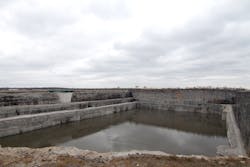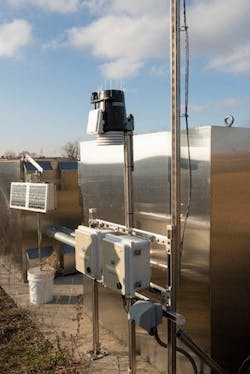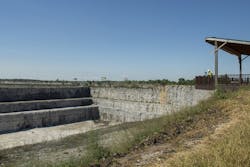Protecting Chicago Reservoirs
Allison Fore is public and intergovernmental affairs officer for MWRD. Fore can be reached at [email protected]. Patrick Thomas is public affairs specialist for MWRD. Thomas can be reached at [email protected].
undefinedOn a frigid December afternoon, the Metropolitan Water Reclamation District of Greater Chicago’s (MWRD) Thornton Composite Reservoir in Thornton, Ill., defies the elements.
From the reservoir’s scenic outlook, it feels like standing next to a deep, abandoned pool where the bottom is 300 ft below, its sides are composed of 400-million-year-old limestone, and millions of gallons of water will eventually disappear into the base.
On the other side of this man-made canyon, semi-trailer trucks barrel down the highway above a dam built upon 32,000 cu yd of roller compacted concrete. The narrow strip of road separates the reservoir from an adjoining quarry being mined. Even in its quiet nature, the reservoir is a sight to behold, yet its impact is more remarkable.
Completed in late 2015, the Thornton Composite Reservoir is the largest chapter completed to date in the MWRD’s Tunnel and Reservoir Plan (TARP). Thornton represents one major piece in MWRD’s response to a century-old challenge dealing with combined sewer systems that have a history of funneling storm water and untreated wastewater into local waterways when major rains inundated the area. If the overflow did not pollute the waterways, it flooded the banks of neighboring Thorn Creek, backed up into basements and flooded streets.
Over the last three years, the reservoir has prevented approximately 20.2 billion gal of combined sewage from entering the waterways. In 2018, there were no combined sewer overflows (CSOs) in this area. The reservoir provides an estimated $40 million per year in flood reduction benefits to 556,000 people in 14 communities. It is defying any rainstorm blown its way and proving its worth by improving local waterways and protecting communities from flooding.
In 2006, MWRD completed 109 miles of deep tunnels that zigzag under the Chicago region to provide 2.3 billion gal of storage and offer relief for the excess water that flows into a 375-sq-mile-area of combined sewers. The rock tunnels range in diameter from 8 to 33 ft, and in depth from 150 to 350 ft below the ground. The tunnel sections of TARP capture and store CSOs that previously discharged at hundreds of outfall locations. After storms fill the tunnels and reservoirs with the first flush from combined sewers, the captured CSO is pumped to water reclamation plants for full secondary treatment. The Calumet TARP system, which includes Thornton Composite Reservoir and the adjoining tunnels, has captured more than 99% of the volume of CSO discharges since the reservoir was placed into service.
However, as significant and expansive as the tunnels are, they provide only a fraction of capacity that Thornton possesses. At 7.9 billion gal of storage, the Thornton Composite Reservoir is believed to be the largest reservoir of its kind in the world. It was built to withstand increasing bursts of downpours that have deluged the Midwest. One of those epic rain events that characterized the reservoir’s strength and effectiveness recently occurred.
On Oct. 14, 2017, the Chicago area was hit with 4.34 in. of rain. Thornton took on 2.2 billion gal of water, and there were no reported overflows in the nearby Calumet River System that the reservoir protects. This left 5.7 billion gal of storage capacity available after the major rain event. In fact, the most water the reservoir has taken on to date is about 2.8 billion gal, filling the reservoir only about 35%.
On that occasion, in early April 2017, 4 in. of rain fell following a 10-day period of storms. Seeing that it can take on these significant rain events and continue to have capacity for more water indicates that the system is working. That performance creates peace of mind for nearby residents and for MWRD, as the agency continues to move forward on construction for what will be an even larger facility at the McCook Reservoir. This addition to TARP will take on up to 10 billion gal of water when fully complete by 2029 to serve an even larger area of 3.1 million people.
“Since coming online in 2015, the Thornton Composite Reservoir has proven its worth,” said Kari K. Steele, MWRD president. “It gives us hope that similar systems built at our McCook Reservoir can engineer our way out of major storm events to better protect our water environment and communities from flooding.”
Planning an Engineering Marvel
As development spread through the Chicago area in the mid-20th century, the combined sewer system was increasingly taxed to accommodate increasing amounts of storm water runoff from paved surfaces. By the 1960s, Chicago area sewers were overflowing to the river more than 100 days a year, and flooding had become a persistent issue. The MWRD officially adopted TARP in 1972 and went to work to protect the region from future storms.
TARP was constructed in two phases, beginning with the tunnels and then continuing with the three reservoirs. The Majewski Reservoir came online first, Thornton was second, and the McCook Reservoir would be built in two stages and fully completed by 2029. The reservoirs each connect to the tunnels that will increase the TARP storage volume more than six-fold to 17.5 billion gal. Area water quality has been improving since the tunnels went into service in the mid-1980s. Once completed in 2006, the tunnel portion of TARP cut the number of CSOs in half and prevented an estimated 85% of the CSO pollution. The Thornton and Majewski reservoirs have taken a step further by nearly eliminating CSOs.
The Sweet Smell of Success
Building the largest combined sewer reservoir in the world came with uncertainties—there is no blueprint to follow for an engineering project of this magnitude. Less than a year into operations, odor complaints from neighbors emerged. Odor detection levels were low—in the 5 ppb range—and these levels cause no health risks. However, the MWRD created a task force to address the problem. Complaints were documented and the reservoir was emptied and flushed. More than $4.4 million was invested in odor monitoring controls, including the addition of 13 solar aerators, landscaping, misting systems and other remedies.
In 2018, MWRD scientists partnered with the University of Illinois at Urbana-Champaign and Ensaras Inc., which specializes in wastewater treatment and analytics, to create a predictive model. Using the data analytics, they worked to develop an advanced warning system to efficiently address odors before they emerge. They devised 400 attributes, combing through 2.5 years of data, taking into consideration hydrogen sulfide meters, complaints logged and where they originated, weather, wet wells and drop shafts, relative humidity, wind speed, wind direction, the elevation of the water in the reservoir, and other data.
They developed 37 different algorithms, ultimately selecting a forest algorithm that operates much like a decision tree with its descending tree branches. It tests and researches several variables that work toward predicting the best possible solution and statistical output. Based on these different variables, they determined that installing activated carbon filters over the drop shafts and adding new sensors would better absorb hydrogen sulfide concentrations and control odors. The complaints then subsided.
Proven Results
The success of Thornton is evident in the decreased number of CSOs, but it also is apparent through the improved ecology and water quality of the Chicago Area Waterway System (CAWS). Game fish routinely are caught by anglers, marinas and riverside restaurants abound, river recreation and tourism are booming, and waterfront real estate values have skyrocketed as Chicago-area residents see the river system as a major asset.
TARP tunnels have reduced the number of annual CSO events and have contributed to measurable declines in wet weather concentrations of biochemical oxygen demand and suspended solids, which led to improved dissolved oxygen levels in the water, resulting in healthier waterways. During periodic fish monitoring conducted by the MWRD throughout its service area of the Chicago, Calumet and Des Plaines river systems, the number of fish species has drastically increased. From 10 known species in 1974, the number has ballooned to 77 in 2019, including 60 that have been found in the CAWS since 2000.
TARP cannot fully eliminate CSOs on its own; therefore, MWRD also is working to promote green infrastructure practices, such as rain barrels, green roofs and rain gardens. MWRD also is engaging with communities and advancing policy to regulate development to limit the amount of impervious surfaces that leads to runoff in area collection systems and waterways. Working with multiple partners and residents, MWRD and the Chicago region are embracing a resilient future.


